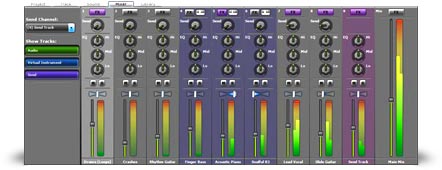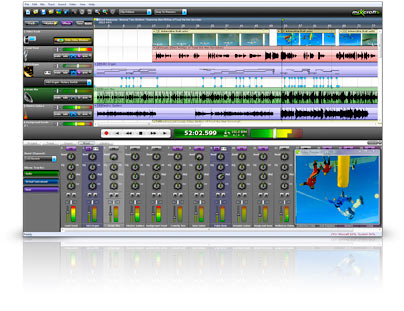|
||||||
I've been following Mixcraft since its original release as various songwriter and musician friends kept referring to its ease of use and capabilities. Since version 1 its functions have been steadily growing while somehow the Mixcraft team managed to keep its price close to the original. I was given version 4 to review but while going to print, the Acoustica team released version 5, so naturally I spent some time with the software to get a feel for the changes. While I honestly couldn't find much to gripe about version 4, version 5 had me ecstatic over the changes and new features. To be honest, I would like to pretty much say - "What are you waiting for? Get it!". However, for the sake of journalistic integrity I'll go on in more details explaining why I think the Acoustica team have really nailed it this time.
Installation
Mixcraft installation is super easy. In the day of challenge/response and all kinds of convoluted registration schemes, installing Mixcraft is simple - you purchase a CD or a download that comes with a serial #, run the installer, type in the serial and you're good to go. No hassle and you're done in less than 2 minutes! I could only wish my other software installs worked this way! I installed the software on my recording machine (4gb RAM, dual AMD XP4200 processor) running Windows XP SP4 and PreSonus Firepod interface via ASIO drivers.
Features
Mixcraft features a linear layout, similar to Apple Garageband or Mackie Tracktion. The interface is laid out in a clean and concise manner, with most functions you need available at the click of a button. The program is a fully featured audio and midi workstation, and supports Acid and Garageband loops. It has the capability to record simultaneous audio and midi, limitations depending on the audio interface and computer power. Included is a decent size royalty-free sample loop library, 8 virtual instruments, including the Acoustica Instruments General MIDI sample library, Acoustica Expanded Instruments sample library, Lounge Lizard Session vintage electric piano, VB3 tonewheel organ, MiniMogueVA monophonic analog synthesizer, Messiah polyphonic analog synthesizer, Alien303 Bass Synthesizer, and Impulse polyphonic analog synthesizer. The software also comes with 20 effects, including the Pultronic Tube EQ, the Shred Amp Simulator (by AcmeBarGig), a complete suite of 5 classic amp heads, 17 cabinet models, and 6 powerful effects. Mixcraft supports VSTi, VST and Direct X plugins and virtual instruments, so if you need to expand your effects or midi instruments, it is very easy to do so. Mixcraft also supports popular audio formats for import (WAV, AIF, OGG, WMA, MP3) and exports into WAV and MP3 format. The software also allows the use of unlimited tracks and effects (results vary based on system resources), features time-stretching algorithm and can run on the following drivers: WDM, ASIO and WaveRT Exclusive Mode, which due to its architecture is available for Windows 7 only. Version 5 of Mixcraft also gets probably what were the most upgrades from owners of previous releases - effects send/return busses and a mixer window. It also adds increased automation features and an incredible value added tool in the Musical Typing Keyboard (MTK) which lets you play your computer keyboard as a midi controller. Version 5 also gets and Notation tool with which you can do a professional music notation. The list of features continues so for full description click here.
In Use
To test Mixcraft I loaded a few songs that I was working on from WAV files and proceeded to build up the compositions and add a few extra parts. The first striking thing was that without a manual I managed to get started tracking right away. Actually throughout the whole time I can't think I ever referred to the manual - everything was where I expected it to be and was pretty much self explanatory. I ran a few realtime amp simulations while tracking guitar and Mixcraft handled them with ease and latency was very low, at about 2-3ms. Mixcraft performed like a champ as I proceeded loading it with more and more files. Compared to other software, such as Cubase LE4 and Tracktion, Mixcraft was running these tracks with less overhead and seemed to be more responsive than the competition. The software comes with its own plugin bundle, guitar amp sims and virtual instruments, which while useful still left something to be desired. The addition of the Pultec inspired Pultronic Tube EQ is definitely a step in the right direction but still this is the only part of the software where I can tell the price point. Luckily for us, Mixcraft runs external VST and Direct X plugins as well and they even encourage supplementing with some freeware VST effects, such as Kjaerhus Audio Classic Series, SIR convolution reverb and so forth. Working with Mixcraft was a very pleasant experience and I noticed that my workflow improved as less clutter meant more music-making. Fader automation is a breeze, as is audio editing - pretty much all the functions that I needed were there. An extra plus was the included audio export to MP3 as some programs, such as Cubase LE charge extra for that option. While mixing I'd have to say that the new mixer view came in real handy and the software's dual monitor mode definitely helped me better organize the workflow - I simply sent the mixer to the second monitor and was happily zipping along with the tracks. Another handy new tool that I found was the new Link Feature - it allowed me to link together a whole section of a song, and move it around as a one piece. This comes in really handy when you're not exactly sure if say your bridge should go between the bridge or the chorus, or maybe the chorus needs to be extended twice. Some other new features that came in really handy were the bounce (Mix to New Audio Track) and MIDI Merging (Mix to New Clip) features. The bounce feature was great when combining several recorded sources of the same guitar signal - in my case I recorded guitar with 3 tracks, one DI that I ran amp emulation on and two mic tracks that I blended to taste, compressed and eq-ed and then bounced to one track to save clutter and conserve system power. The MIDI Merging tool came in handy when I needed to merge a midi drum sample to my tapped-in-via keyboard conga parts so I could run only one midi track for simplicity's sake.
definitely helped me better organize the workflow - I simply sent the mixer to the second monitor and was happily zipping along with the tracks. Another handy new tool that I found was the new Link Feature - it allowed me to link together a whole section of a song, and move it around as a one piece. This comes in really handy when you're not exactly sure if say your bridge should go between the bridge or the chorus, or maybe the chorus needs to be extended twice. Some other new features that came in really handy were the bounce (Mix to New Audio Track) and MIDI Merging (Mix to New Clip) features. The bounce feature was great when combining several recorded sources of the same guitar signal - in my case I recorded guitar with 3 tracks, one DI that I ran amp emulation on and two mic tracks that I blended to taste, compressed and eq-ed and then bounced to one track to save clutter and conserve system power. The MIDI Merging tool came in handy when I needed to merge a midi drum sample to my tapped-in-via keyboard conga parts so I could run only one midi track for simplicity's sake.
Overall Mixcraft have managed to create very impressive software, with lots of features that can appeal to novice and veteran users. It is easy to get started on and achieve fast quality results. If you find yourself pulling your hair with the complexities of your more expensive DAW - spare yourself the trouble and give Mixcraft a spin!




